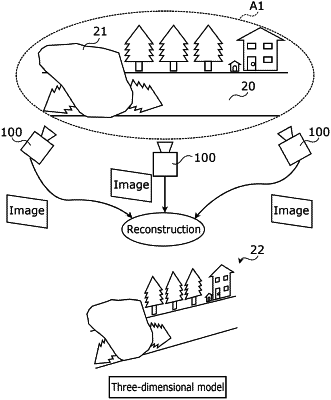| CPC G06T 7/344 (2017.01) [G06T 17/00 (2013.01); G06T 19/20 (2013.01); G06T 2207/20224 (2013.01); G06T 2219/2004 (2013.01)] | 14 Claims |

|
1. An object amount calculation apparatus, comprising:
a receiver configured to obtain a first three-dimensional model and a second three-dimensional model different from the first three-dimensional model, each of the first three-dimensional model and the second three-dimensional model representing a same space, the first three-dimensional model corresponding to a first point in time and the second three-dimensional model corresponding to a point in time different from the first point in time, each of the first three-dimensional model and the second three-dimensional model being constituted with regions having respective attributes,
the object amount calculation apparatus further comprising:
a processor configured to:
extract at least one attribute of the first three-dimensional model and the second three-dimensional model;
align the first three-dimensional model and the second three-dimensional model based on the at least one attribute of the first three-dimensional model and the second three-dimensional model that has been extracted, wherein the at least one attribute is information indicating a result of recognition of an object type in a respective region in the first three-dimensional model and the second three-dimensional model;
calculate, for each of the attributes, a difference between the first three-dimensional model aligned and the second three-dimensional model aligned, wherein the difference includes an attribute of the first three-dimensional model and the second three-dimensional model that shows a change between the first three-dimensional model and the second three-dimensional model; and
output (i) a total amount of differences corresponding to two or more attributes among the attributes and (ii) information on the two or more attributes.
|